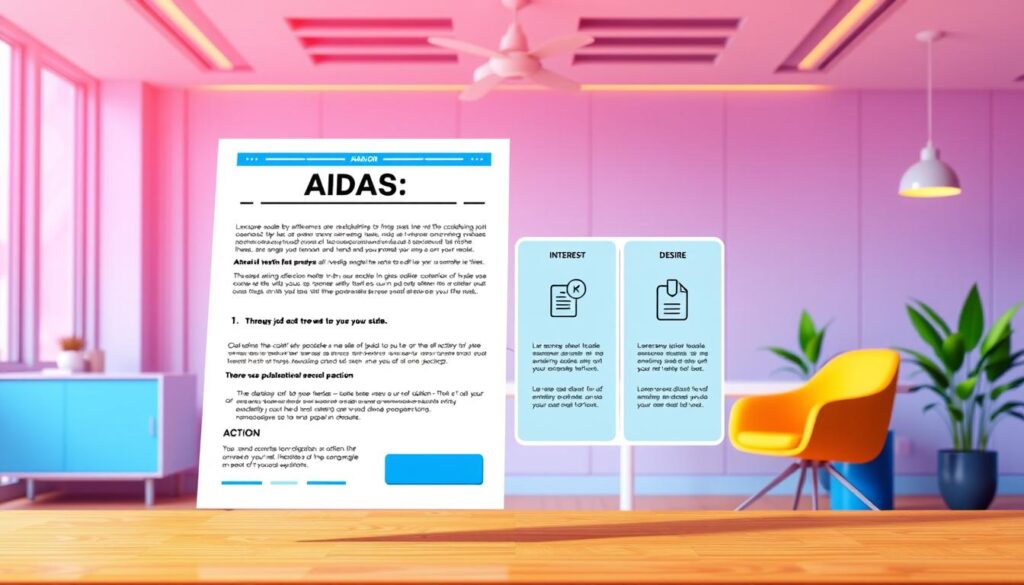Recruiting the right people is tougher than ever. A staggering 77% of employers report difficulty filling roles with skilled professionals. The problem? Many businesses rely on outdated hiring methods that fail to engage qualified candidates.
Well-crafted listings act as a bridge between employers and hidden talent pools. They highlight company culture, growth opportunities, and key responsibilities—turning passive job seekers into eager applicants. Research from Opportunity@Work reveals millions of skilled workers are overlooked due to poorly structured recruitment efforts.
This guide explores the AIDA model (Attention, Interest, Desire, Action) and 10 must-have elements for high-performing listings. Discover how Innovate Corp boosted applications by 40% by refining their HR Manager ad—and avoid common pitfalls that repel top-tier candidates.
Key Takeaways
- 77% of companies face challenges hiring skilled professionals.
- Optimized listings connect businesses with overlooked talent.
- The AIDA framework increases candidate engagement.
- Real-world examples prove the impact of strategic ad design.
- Poorly structured ads deter qualified applicants.
Why Job Ads Are Your First Impression on Candidates
Top talent forms opinions about your workplace before they even apply. Listings act as a trailer for your company’s blockbuster—revealing values, mission, and daily life. Get it wrong, and 66% of seekers will skip non-aligned roles.
The Role of Job Ads in Employer Branding
Your employer brand shines through every word. Avid4Adventure boosted applications by embedding team videos in listings—showcasing real culture. Meanwhile, vague titles like “Sales Ninja” confuse candidates and hurt credibility.
Millennials prioritize purpose: 87% choose employers supporting social causes. Clear diversity efforts matter too—75% of professionals avoid companies lacking them.
Setting the Tone for Candidate Experience
GWV reduced turnover by outlining growth paths in ads. Transparency builds trust. Listings should answer:
- What does a day in this role look like?
- How does the team collaborate?
- What impact will the hire make?
Strong ads filter mismatches early, saving time for both sides. They don’t just attract candidates—they attract the right ones.
How to Create Job Ads That Attract Talent Using the AIDA Model
Standout listings act as talent magnets in competitive markets. The AIDA model (Attention, Interest, Desire, Action) transforms generic listings into compelling narratives. Here’s how to apply it.
Attention: Crafting Headlines That Stand Out
Generic titles like “Software Engineer” get lost. Instead, try “Code Whisperer – Building Future Tech.” This sparks curiosity. Research shows 88% of candidates demand clarity upfront.

Interest: Highlighting Unique Role and Culture
Convert bullet points into stories. Describe a day in the role or team rituals. Innovate Corp boosted engagement by detailing their hybrid work model.
Desire: Showcasing Growth and Benefits
Salary transparency builds trust—list ranges. Mention mentorship opportunities or unique perks. GWV reduced turnover by outlining career paths.
Action: Clear Calls-to-Action
Use urgency: “Apply by Friday” outperforms passive prompts. Align CTAs with legal requirements, as GWV advises.
10 Essential Elements of an Effective Job Ad
A well-structured listing acts as a silent recruiter, pulling in qualified professionals. These components transform generic posts into compelling invitations for top-tier talent.
1. Intriguing Job Titles That Spark Curiosity
Generic labels like “Front Desk Agent” blend in. Instead, try “Hospitality Ambassador – Crafting Guest Experiences.” Clarity matters—88% of candidates prefer descriptive job titles.
2. Engaging Introductions With Questions
Start with hooks: “Ready to revolutionize our tech stack?” Questions draw readers in and set the tone for the role.
3. Clear Ideal Candidate Profiles
Define must-have skills versus nice-to-haves. Example: “3+ years in SaaS sales” beats “rockstar negotiator.”
4. Detailed Responsibilities and Daily Tasks
Paint a vivid picture. “Lead weekly client check-ins” is clearer than “manage relationships.”
5. Authentic Company Culture Insights
Share team rituals or charity projects. Photos boost engagement—52% of candidates value visual content.
6. Transparent Salary and Benefits
List ranges like “$75K–$90K.” GWV found this reduces mismatches early. Highlight unique perks, too.
7. Realistic Qualifications and Skills
Avoid overloading requirements. Focus on core competencies to widen your talent pool.
8. Visual Content (Photos/Videos)
Team photos rank in top six decision factors. Show real employees in action.
9. Company Achievements and Values
Mention awards or diversity stats. Example: “Named Best Workplace for Women 2023.”
10. Easy Application Instructions
Simplify steps: “Upload resume + 2-minute video.” Complex processes deter 60% of applicants.
Combine these elements to craft listings that resonate. A strategic approach turns seekers into applicants—and applicants into hires.
Optimizing Job Ads for Candidate Engagement
Modern hiring demands listings tailored for both humans and algorithms. A balanced approach ensures visibility while resonating with qualified professionals. Below are three pillars to elevate your job page.
Strategic Keyword Integration
Google penalizes keyword-stuffed titles, but 4–5 repetitions boost relevance. Compare “graphic designer” (high volume) with “multimedia specialist” (lower competition).
Place keywords naturally:
- Title: “UX Designer – Remote” (location + role)
- Body: “Lead content strategy for mobile apps”
Readability-Driven Formatting
Break dense paragraphs for mobile screens. GWV’s skills-first approach uses bullet points for core competencies. STARS templates recommend:
- Headers for each section (Responsibilities, Culture)
- Bilingual postings to widen applicant pools
Audience-Centric Language
Replace jargon like “synergize cross-functional teams” with “collaborate daily with marketing.” Bilingual listings improve diversity—Second Source notes a 30% rise in qualified applicants.
Tailor tone to roles: Tech candidates prefer concise specs, while creative roles thrive on storytelling.
The Power of Transparency: Salary and Benefits
Modern professionals demand upfront transparency in compensation. Vague terms like “competitive salary” deter 72% of applicants, according to Third Source. Clear ranges build trust and reduce mismatches early.
Why Salary Ranges Matter to Candidates
Gen Z ranks salary as their top career priority. Listing ranges (e.g., “$65K–$80K”) speeds up hiring by 31 days. GWV saw a 40% rise in qualified employee referrals after adopting this practice.
Healthcare benefits sway 60% of candidates. Highlight specifics: “100% premium coverage for dental and vision.” Avoid generic phrases—detail PTO policies and retirement plans.
Highlighting Unique Perks and Growth Opportunities
Innovate Corp’s “transformative projects” phrasing boosted engagement. Mention mentorship programs or skill-building opportunities. Example: “Quarterly hackathons with executive feedback.”
GWV’s negotiation openness tip: “Flexible sign-on bonuses for top talent.” Pair monetary perks with culture-driven ones, like volunteer days or remote stipends.
Leveraging Social Media and Job Boards
Social media and job boards act as talent gateways for modern employers. Choosing the right platforms ensures your listings reach active and passive candidates. A strategic mix maximizes visibility while aligning with your hiring goals.

Choosing the Right Platforms for Distribution
LinkedIn dominates professional networking, ideal for white-collar roles. Indeed excels for high-volume hiring, while niche boards like AngelList attract startups. Avid4Adventure doubled applications by cross-posting on outdoor industry forums.
Paid campaigns on social media target specific demographics. Organic posts with hashtags (#HiringNow) extend reach. GWV’s statewide partnerships with regional boards boosted local talent acquisition by 30%.
Amplifying Reach with Employee Networks
Employee advocacy turns staff into recruiters. Teach teams to share listings with personalized notes. WorkBright’s 15-minute ATS demo simplifies internal referrals.
Use templates for consistency:
“We’re hiring! 🚀 Join our [Team] as a [Role]. DM for details. #LifeAt[Company]”
GWV’s generational program tailors messaging to Gen Z (TikTok) and Boomers (Facebook).
Balance paid and organic efforts. Allocate 70% of budgets to high-conversion platforms like LinkedIn. Track metrics—cost-per-hire drops 40% with optimized targeting.
Common Mistakes to Avoid in Job Ads
Many employers unknowingly sabotage their hiring efforts with poorly structured listings. First Source reports 63% of qualified candidates abandon applications due to confusing requirements. These errors create unnecessary barriers in the hiring process.
Overusing Jargon or Vague Titles
Terms like “coding ninja” or “marketing guru” alienate 52% of professionals, per First Source. Instead, use clear titles such as “Python Developer – FinTech Solutions.
Bullet points work better than dense paragraphs. GWV’s A/B tests show 40% higher completion rates with scannable formats.
Neglecting Diversity and Inclusion Efforts
Generic statements like “We value diversity” lack impact. Specific DEI practices attract wider talent pools. Example: “40% of our engineers identify as women” builds credibility.
GWV’s template includes pronoun fields and accessibility accommodations. This improves candidate experience for underrepresented groups.
Omitting Critical Details
Second Source found 52% of applicants prioritize remote policies. Listings without location flexibility lose top talent. Clearly state hybrid schedules or travel expectations.
Growth projections matter too. “Promotion paths available after 12 months” outperforms vague career promises by 3:1 in engagement.
Conclusion
Strong listings turn browsing professionals into eager applicants. The AIDA model and 10-element checklist help craft compelling content. GWV’s data shows a 15% faster hiring process when these strategies are applied.
Transparency drives results—88% of candidates prioritize clear salary details. For immediate help, contact Melanie Taylor at GWV. Streamline onboarding with WorkBright’s tools or explore the STARS Hiring Playbook.
Every word in your listing shapes perceptions. Refine your approach to connect with the right talent efficiently. Small changes yield big rewards in the hiring process.
FAQ
Why are job ads crucial for employer branding?
Job ads shape candidates’ first impression of your company. A well-crafted ad reflects your culture, values, and professionalism, making your employer brand more appealing to top talent.
How can the AIDA model improve job ads?
The AIDA model (Attention, Interest, Desire, Action) helps structure ads for maximum impact. Strong headlines grab attention, engaging content builds interest, benefits create desire, and clear CTAs drive action.
What elements make a job ad stand out?
Effective ads include compelling titles, clear responsibilities, salary transparency, company culture insights, and easy application steps. Visuals and employee testimonials also boost engagement.
Should job ads include salary information?
Yes. Transparent salary ranges attract more qualified candidates and save time for both employers and applicants. Highlighting benefits and perks further strengthens appeal.
How can social media enhance job ad reach?
Platforms like LinkedIn, Twitter, and industry-specific boards expand visibility. Employee shares amplify organic reach, while targeted ads attract passive candidates.
What common mistakes should employers avoid?
Avoid vague job titles, excessive jargon, or unrealistic requirements. Ensure diversity-focused language and include remote-work policies if applicable.
How do SEO keywords help in job ads?
Keywords like “remote opportunities” or “career growth” improve search visibility. Use terms candidates frequently search for while keeping the content natural.
Why is company culture important in job ads?
Candidates prioritize workplaces aligned with their values. Showcasing culture through team photos or mission statements helps attract the right fit.



